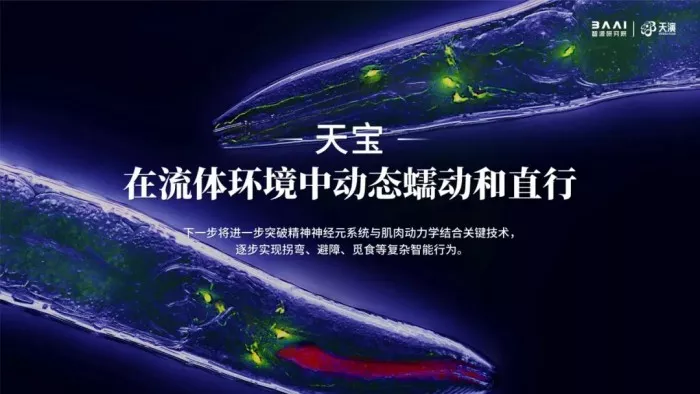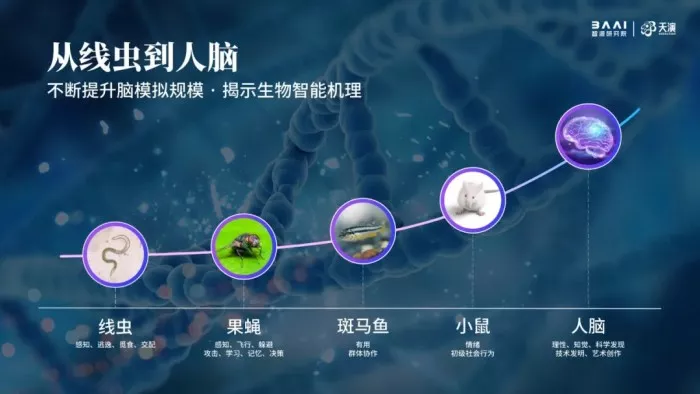Recently, at the opening ceremony of the 2022 Zhiyuan conference, Beijing Zhiyuan Artificial Intelligence Research Institute (hereinafter referred to as Zhiyuan Research Institute) released the latest scientific research achievements of the Tianyan team, high-precision intelligent nematode Tianbao 1.0** In the picture, a "Caenorhabditis elegans" (hereinafter referred to as "Caenorhabditis elegans") is crawling forward, just like a real one. This scene made many audience in front of the screen wide eyed.

◎ our reporter fulili
Ma Lei, head of the life simulation research center of Zhiyuan Research Institute, introduced that by calculating the neuroelectrodynamic signals of Caenorhabditis elegans, they are transmitted to the muscle model, which is continuously transmitted to the front part of the interaction with the environment, and then through the interaction between the muscle of Caenorhabditis elegans and the water environment, the creeping forward can be realized.
"At present, it has only initially demonstrated the ability of seeking benefits (food) and avoiding hazards (poisons) similar to biological nematodes. In the next stage, it will gradually realize complex intelligent behaviors such as turning corners, avoiding obstacles and foraging." Marley said.

It is understood that as a non-toxic and independent model animal, Caenorhabditis elegans has simple structure but complete functions: it is only about 1mm long and has 302 neurons, but it is enough to complete a series of general intelligent behaviors such as perception, escape, foraging, mating, etc.
This transparent little creature is a "frequent visitor" in the scientific research community. In the past 20 years, three Nobel prizes have been related to it. It is the "simplest life agent" and the smallest carrier to realize general artificial intelligence through biological neural mechanism simulation.

In October, 2020, nature published a paper on neurons, and the media used the title "19 neurons control a autonomous vehicle".
"Although this is somewhat exaggerated, it also reflects the great potential of biological neuron computing." Marey said that the reason for making a high-precision neuron model of C. elegans is that biological neurons represent biological intelligence. The higher the degree of refinement, the higher the level of intelligence. The realization of a higher-precision C. elegans nervous system can help to tap more potential of biological intelligence.

"The simulation of intelligent life is a long-term but promising project." Said huangtiejun, President of the Intelligent Research Institute.
At present, the high-precision Caenorhabditis elegans model has broken through the key technology of the combination of nervous system and muscle dynamics, and is expected to promote the fine simulation of biological neurons into a new field. "Our goal is to explore the mechanism of biological intelligence and inspire and explore a new generation of artificial intelligence by building a life intelligence model." Huang Tiejun emphasized.
This is the most accurate simulation of C. elegans. Ma Lei introduced that he and his team have completed the fine modeling of all 302 neurons and their connections of Caenorhabditis elegans, of which 106 sensory and motor neurons have been modeled with high precision, and the overall precision has reached the highest level in the world; The neuron structure simulation adopts the multi compartment model, with a maximum of 2313 single neuron compartments. The neuron physiological simulation supports 14 kinds of ion channels and realizes the fine synaptic site connection at the subcellular level.

"Environment is the cradle of intelligence." Marey said that extreme environmental simulation is crucial to the research of digital intelligent life. The environment has changed, and the structure, behavior, wisdom and complexity of the corresponding life body are greatly different.
To this end, the team also realized the full closed-loop simulation of the simulated Caenorhabditis elegans and the simulation environment, trained the simulated Caenorhabditis elegans controlled by the high-precision neural system and interacted with the environment in real time, so that they can sniff and control the body movement to interested targets like the real nematodes.
"The birth of high-precision intelligent nematodes may only be the first step towards life intelligence, but it represents the birth of a computational intelligence life." Huang Tiejun said.

Huang Tiejun said that in the future, the Tianyan team will also strive to achieve multiple neural system scale life digital twins, from fruit flies, zebrafish, mice to the most intelligent human brain, and make the scale of life simulation larger and larger along the neural system scale evolution route of model animals.
"Of course, large scale is only one aspect. More importantly, it is fine. Only by being close to and approaching biology can we re understand the mechanism of biological intelligence and create a feasible path from life intelligence to general artificial intelligence, so as to really play a supporting role in the new generation of artificial intelligence." Huang Tiejun said.
